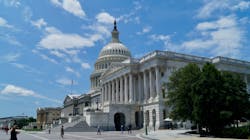U.S. House Members request more than $2.2 billion for 343 transit projects as part of surface transportation reauthorization
The House Transportation & Infrastructure Committee published a list of 2,380 projects 318 House Members have submitted to be considered as part of a future surface transportation bill. Included in the submissions is $2.27 billion for 343 transit projects from 37 states, the District of Columbia, Guam and Northern Mariana Islands.
The member designated projects, informally referred to as earmarks, will be limited to one percent of total discretionary spending within a future bill and House Members were limited to 10 projects to submit for consideration, but there are no guarantees as to which projects will be included.
Both parties took advantage of the process with 213 Democratic House Members submitting 1,775 projects for consideration and 105 Republican House Members submitting 605 projects.
“I commend my colleagues and their staff who went through the rigorous steps to submit Member Designated Projects under the reformed system, which we adopted to ensure transparency in the process and viability of the projects,” Committee Chair Peter DeFazio (D-OR-04) said. “It’s not an easy process, but it is important because I strongly believe elected representatives—working with their communities—know the specific infrastructure needs of their district far better than most people in D.C. and can serve as their constituents’ best advocates as Congress crafts infrastructure legislation.”
Included in the transit specific projects are 55 station or transit hub requests, 23 operations and maintenance facilities and nearly 50 projects to help fund zero-emission fleet transitions or install supporting infrastructure such as charging stations or hydrogen fueling stations.
While most projects submitted for consideration included requested funding of between $5 million and $25 million, the largest transit funding request was submitted by Rep. Eric Swalwell (D-CA-15). He requested $250 million for Bay Area Rapid Transit’s (BART) Link21 Program, a multi-year, multi-phase program, which aims to integrate North California’s passenger rail network. On the opposite side of the spectrum is Rep. Ayanna Pressley (D-MA-07), who submitted a request of $100,000 for the Davis Square Transit Signal Priority Project in Somerville, Mass.
Several high-profile transit projects were submitted for consideration, including Virginia Department of Rail and Public Transportation’s Long Bridge project, which will construct two bridges across the Potomac River connecting Washington, D.C., and Virginia. The new bridges will separate freight and passenger rail traffic and provide pedestrians and cyclists with a connection. The project was submitted with a $20-million funding request from Rep. Abigail Spanberger (D-VA-18), as well as a $4-million funding request from Rep. Don Beyer (D-VA-08).
In order to submit projects, House Members included several pieces of information including if the project was in the state, tribal or territorial transportation improvement program (STIP) or metropolitan transportation improvement program (TIP), the project phase, sources of funding, among other information such as certification that the member, their spouse and other immediate family members do not have financial interest in a project.
“The committee established a thorough set of requirements for any members choosing to submit requests, and now posting all submissions in one location will help ensure the highest level of transparency,” said Committee Ranking Member Sam Graves (R-MO-06).
Chair DeFazio added, “I was pleased by the high level of participation, on a bipartisan basis, in this process. Now I look forward to advancing our surface bill soon, complete with Member Designated Projects, and working with all my colleagues to send a transformational bill that creates jobs and improves our communities to the president’s desk.”
A full list of projects submitted for consideration can be viewed on the House T&I Committee website.
---
Editor’s Note: “Transit project” was classified as a transit vehicle, station/facility, technology or other hard infrastructure project primarily used for the purpose of mass transit. Active transportation projects such as bike lanes or pedestrian improvements were not included in the tally. The editors encourage readers to review the full list of projects.
About the Author

Mischa Wanek-Libman
Group Editorial Director
Mischa Wanek-Libman is director of communications with Transdev North America. She has more than 20 years of experience working in the transportation industry covering construction projects, engineering challenges, transit and rail operations and best practices.
Wanek-Libman has held top editorial positions at freight rail and public transportation business-to-business publications including as editor-in-chief and editorial director of Mass Transit from 2018-2024. She has been recognized for editorial excellence through her individual work, as well as for collaborative content.
She is an active member of the American Public Transportation Association's Marketing and Communications Committee and served 14 years as a Board Observer on the National Railroad Construction and Maintenance Association (NRC) Board of Directors.
She is a graduate of Drake University in Des Moines, Iowa, where she earned a Bachelor of Arts degree in Journalism and Mass Communication.
